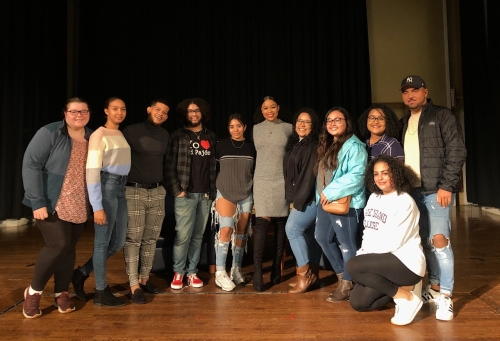Students and Faculty Address Colorism Across Diverse Communities, Part 1: What is Colorism?
- News & Events
- News
- Students and Faculty Address Colorism Across Diverse Communities, Part 1: What is Colorism?

Here in the United States, colorism is a topic that concerns many racial or ethnic communities, especially those that encompass a variety of skin colors.
“Colorism” is a word that doesn’t even exist in many languages – at least, not officially. Even in English, it autocorrects on one’s computer screen and, until recently, could not be found in the dictionary, which now describes colorism as prejudice or discrimination against individuals with dark skin tone, typically among people of the same ethnic or racial group.
Here in the United States, colorism is a topic that concerns many racial or ethnic communities, especially those that encompass a variety of skin colors.
Daniel Clarkin, a proud Latino from Puerto Rico and co-president of UNIDOS, a Hispanic group at Rhode Island College, explains that “colorism goes back to how European settlers founded colonies on our continent and how they stablished dominance and social hierarchy based upon complexion. Back then, your job and function in society completely depended on the color of your skin, your race. If you were black you were a slave, if you were indigenous you were a servant, and if you were white you probably had lands and more freedom.”
RIC Assistant Professor Soumyadeep Mukherjee is from India, a nation that has dealt with colorism for decades. He agrees with Clarkin about European influence. “Most of the world at some time was being dominated by the European conquerors,” he notes. “India, for example, was a British colony for more than 200 years and that is definitely a strong cause of colorism.”
Jayana Greene, a proud African-American woman, and former vice-presidents of RIC black student organization Harambee, says that “colorism is an entitlement that has been passed on since slavery, when people were classified in terms of field slaves or house slaves.” Back then, enslaved people with lighter skin were allowed in the household, while those with darker skin were sent to the fields. “It adds to the mentality that the closer you are to a lighter skin complexion, the more privileges you have,” she adds.
Clarkin believes that colorism causes separation both within and among racial and ethnic groups across the United States society. “We as minorities are trying to fight to get into second place,” he says. “In the United States a person who is white with blue eyes gets treated with more respect and has more command over a room without even saying anything, even if they are Latino.”
Mukherjee recalls that in India people grow up looking at advertisements and TV shows that condition people how to look at themselves and their skin color. “Since the mid-70s, there has been a popular ad campaign for a lightening skin care product for young women, over time for young men too. It’s probably one of the highest-selling cosmetic products in the Indian market,” he recalls. “It is kind of the same here in the U.S. where a lot of adolescents also use lightening products to bleach their skin, which is harmful for them.” There is a $23-billion-dollar industry in the United States that includes products like these and other methods such as cosmetic surgery to help people conform to these Eurocentric standards of body image and color.
Although Clarkin has not seen the use of lightening products within the Latino community, he notes that in places like India, the Philippines, Jamaica, and some west African countries, it is very popular. “It is kind of scary because people are putting their health at risk. This shows how dangerous it is to have unrealistic standards of beauty,” he says. “We want to be white so bad that we put down black and brown people. The world is so Eurocentric that it diminishes the looks of people in every other area of the world.”
Greene has seen this behavior before in a trip to India. “The same subject was talked about, lighter and darker skinned women, people buying lighting cream,” she recalls.
For Mukherjee those products are essentially part of all the social and psychological impact of colorism and its roots in colonial history. “We have this idea of beauty and skin color, body type and body image, as a Eurocentric standard,” he explains. “We consciously or unconsciously are engaging in this kind of stereotype.”
“It is time to change beauty standards across the board to a more international perspective,” says Clarkin. “We cannot leave it up to reality show celebrities or models who represent the Eurocentric standard of beauty. It needs to be more diverse and include everybody, period.”
Mukherjee notes that these conversations have started to shift opinion in India, where some celebrities have stopped endorsing lightening products. Even the companies that make them are rebranding the product to reduce the perception of favoring lighter skin.
Greene believes that people should really accept who they are and that, in some ways, people are shifting into that behavior. “There is more representation within the beauty industry with darker skin women being in ads for makeup and getting leading roles in movies,” she says. “It’s something that will get children to admire. The generations to come will see that the representation of beauty standards have changed and started to break those colorism barriers.”
